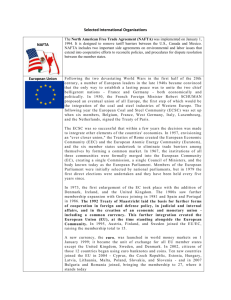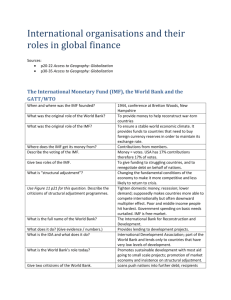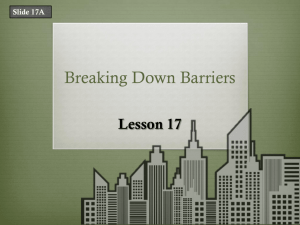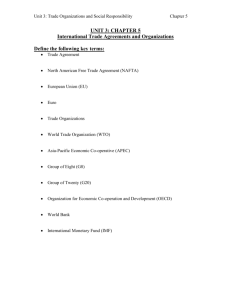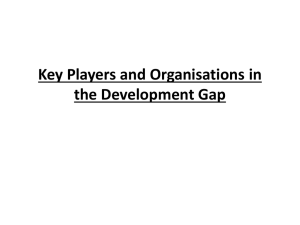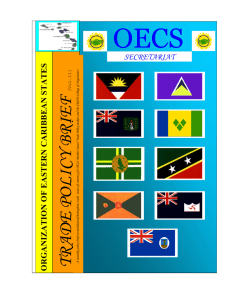PPT
advertisement
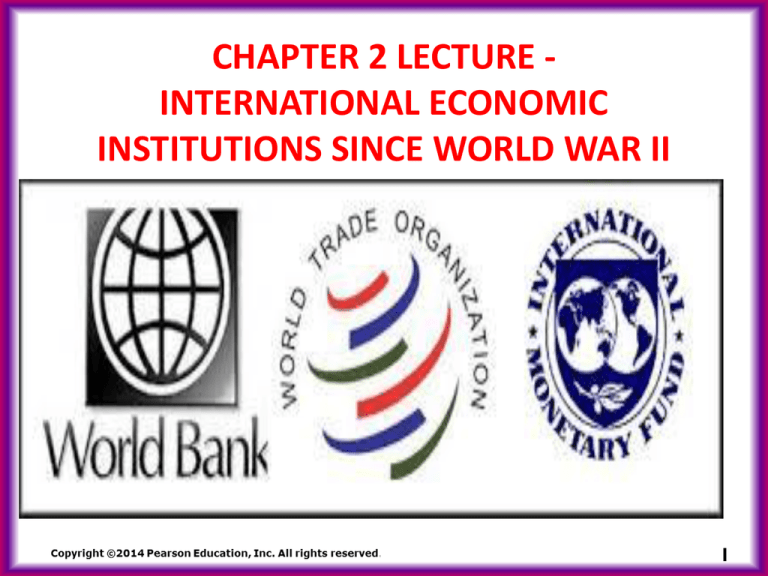
CHAPTER 2 LECTURE INTERNATIONAL ECONOMIC INSTITUTIONS SINCE WORLD WAR II 1 LEARNING OBJECTIVES • Classify and give examples of the main types of international economic organizations. • Compare and give examples of the different levels of integration found in regional trade agreements. • Analyze the roles of international economic organizations. • Discuss common criticisms of international economic organizations 2 INTRODUCTION: INTERNATIONAL INSTITUTIONS AND ISSUES SINCE WORLD WAR II • International institutions: Rules and organizations that govern and constrain behavior – Formal institutions: Written sets of rules that explicitly state what is and is not allowed – Informal institutions: Customs or traditions that define appropriate behavior, but without legal enforcement 3 A TAXONOMY OF INTERNATIONAL ECONOMIC INSTITUTIONS, WITH EXAMPLES 4 THE IMF, THE WORLD BANK, AND THE WTO The three global organizations that play a major role in international economic relations are: – The International Monetary Fund (IMF) – The World Bank – The World Trade Organization (WTO) 5 THE INTERNATIONAL MONETARY FUND (IMF) • Founded by 29 countries (1945) at the Bretton Woods conference in July 1944 • The 188 member (2012) IMF is the central monetary institution in today’s international economy • Funding for the IMF comes from its membership fee, or quota (the price of membership) • depends on size of the economy • Importance of its currency in world trade http://www.imf.org/external/index.htm 6 THE IMF The most visible role for the IMF is to intercede, by invitation, whenever a nation experiences a crisis in its international payments. For example, if a country imports more than it exports, then it may run out of foreign exchange reserves. 7 THE IMF • Foreign exchange reserves are dollars, yen, pounds, euros, or another currency (or gold) that is accepted internationally. • In the event of a financial crisis, – Members borrow against IMF quotas – IMF conditionality: Requirement for the borrowing member to carry out economic reforms in exchange for a loan • IMF has its own currency, called an SDR, or special drawing right • SDRs are based on a country’s quota and are a part of its international reserves. 8 THE WORLD BANK • Has same membership and similar structure to IMF • Member’s voting rights are proportional to number of shares owned • Original purpose - To provide financing mechanisms to rebuild Europe after World War II • Main function today - Assisting development in non-industrial economies http://www.worldbank.org/ 9 KEY DIFFERENCE BETWEEN THE IMF AND THE WORLD BANK • IMF: – – – – Exchange rate stability Monetary policy Mission creep development Loans are large for macro-targets ($100s millions-billions) • World Bank – – – – Development Smaller loans ($10s millions-$100 millions) Specific projects (dam, schools, oil pipeline) Multiple projects in one country (big countries may have several project loans, e.g., India >10) 10 THE WORLD BANK • Critics (e.g. Easterly 2005) allege that the World Bank has fallen far short of its goals of improving living standards and reducing poverty. • Many argue that failure is due to the imposition of misguided policy conditions through the development projects. 11 SOME REASONS THE TWO INSTITUTIONS OFTEN GET CONFUSED • Like the IMF, World Bank uses conditionality with many (but not all) loans • Often, the World Bank requires an IMF program be in good standing! – So the conditionality may run through the IMF • Both institutions founded in 1944 @ BW, NH • Both have a similar governance structure 12 THE GATT, THE URUGUAY ROUND, AND THE WTO • Began with 23 nations in 1946 when the International Trade Organization (ITO) was established • The General Agreement on Trade and Tariffs (GATT) followed in 1950 • The GATT functioned through trade rounds: Times when countries periodically negotiate a set of incremental tariff reductions • During the Kennedy Round in the mid-1960’s, and the Tokyo Round in the 1970’s, other issues included: - Problems with dumping - Subsidies to industry - Nontariff barriers to trade 13 THE GATT, THE URUGUAY ROUND, AND THE WTO • The Uruguay Round established the WTO (1995) • The Doha Round/Doha Development Agenda (20012006) – Focused on trade issues of importance to developing countries • The General Agreement on Trade and Tariffs (GATT) followed the following principles: – National treatment: Imports must be given similar treatment on the domestic market as domestically produced goods – Nondiscrimination: Enshrined in the concept of most favored nation (MFN); a prohibition against discrimination 14 THE GATT ROUNDS 15 THE THREE MAIN INSTITUTIONS • Reputation Today: Criticized by – Opponents of globalization – Opponents of corporations – Some in Developing Countries for dominance • by US • by rich countries • by corporations – Some in US for undermining US power – Scholars for institutional flaws • IMF: Has sometimes imposed misguided policies • World Bank: Wastes resources on corrupt elites • WTO: Dominated by rich countries, corporations 16 THE THREE MAIN INSTITUTIONS Reputation today, among some: 17 REGIONAL TRADE AGREEMENTS • Regional trade agreements (RTAs) between two (bilateral) or • Several countries (plurilateral) are another important institution in the world economy, • Called multilateral agreement because it includes, potentially, all the countries of the world. 18 FIVE TYPES OF REGIONAL TRADE AGREEMENTS 19 PROMINENT REGIONAL TRADE BLOCS 20 PROMINENT REGIONAL TRADE BLOCS 21 FIVE TYPES OF REGIONAL TRADE AGREEMENTS 1. Partial trade agreement: Two or more countries agree to drop trade barriers in a selected group of product categories such as steel or autos 2. Free-trade area: Nations trade goods and services across international boundaries without paying a tariff and without the limitations imposed by quotas 3. Customs union (CU): An FTA plus a common external tariff (CET) – – European Union in the 1970s and 1980s MERCOSUR in South America 22 FIVE TYPES OF REGIONAL TRADE AGREEMENTS 4. Common market: A CU plus an agreement to allow the free mobility of inputs, such as labor and capital. - The European Union in the 1990s 5. Economic Union: A common market with coordination of macroeconomic policies (including common currency, harmonization of standards and regulations) – United States – Canada – European Union members participating in the Euro currency zone 23 REGIONAL TRADE AGREEMENTS AND THE WTO • Since 1948, over 500 agreements have been listed with the WTO; with majority of the notifications since 1990 • 338 of these agreements are still active (2012) • The WTO and GATT allow RTAs, assuming they create more new trade than they destroy - trade creation > trade diversion 24 FOR AND AGAINST RTAS • The central economic question: • Are RTAs supportive of gradual, long run increases in world trade (building blocks), or • Do they tend to become obstacles to further relaxation of trade barriers (stumbling blocks)? • Proponents of RTAs view them as building blocks toward freer, more open, world trade • Opponents view RTAs as undermining progress toward multilateral (worldwide) agreements 25 FOR AND AGAINST RTAS Opponents question many of these assumptions: 1. Their greatest criticism is that RTAs undermine progress toward multilateral (worldwide) agreements. 2. Pro-trade opponents of RTAs do not believe that they encourage agreements through the WTO 3. Opponents point out that RTAs are often discriminatory against poor and less-developed countries 26 FOR AND AGAINST RTAS Proponents have several arguments on their side. 1. Easier for a few countries to reach agreement than it is for all the countries in the WTO. 2. The domestic effects of a reduction of trade barriers are less dramatic. 3. RTA member countries can experiment with new agreements. 4. RTAs can be used as a political and economic threat to encourage agreements in the WTO. 27 OTHER INSTITUTIONS • G-7, G-8, G-20: These are Groups of countries – G-7 = US, Canada, Japan, Britain, France, Germany, Italy • Finance ministers meet regularly • Heads of state meet annually – G-8 = G-7 + Russia (1998-2014) • Heads of state met annually, for a few years – G-20 = G-8 + Australia & EU, + 10 major EMEs (Emerging Market Economies) = 19 Countries + EU 28 OTHER INSTITUTIONS • UN = United Nations – UNCTAD (United Nations Conference on Trade and Development) – ILO (International Labor Organization) – WIPO (World Intellectual Property Organization) 29 OTHER INSTITUTIONS • EU = European Union • NAFTA = North American Free Trade Area (or Agreement) • OECD = Organization for Economic Cooperation and Development – Club of mostly high-income countries – Does research, collects data, drafts policies – Does not have any direct power 30 THE ROLE OF INTERNATIONAL ECONOMIC INSTITUTIONS • The primary difference between international institutions and national governments is that the former have limited enforcement power • However, international institutions help provide order and reduce uncertainty • Order and certainty are public goods— intangibles that are different from most goods and services 31 DEFINITION OF PUBLIC GOODS • Public goods are: – Nonexcludable: The normal price mechanism does not work as a way of regulating access to them – Nonrival (or nondiminishable): They are not diminished or reduced by consumption • Private markets fail to supply public goods because of free riding: People have no incentive to pay for a public good because they cannot be excluded from its consumption even if they don’t pay 32 FOUR EXAMPLES OF INTERNATIONAL PUBLIC GOODS 33 MAINTAINING ORDER AND REDUCING UNCERTAINTY • Two important functions of international economic institutions to reduce free riding are: • Maintaining order in international economic relations • Reducing uncertainty 34 CRITICISM OF INTERNATIONAL INSTITUTIONS International institutions receive three types of criticism 1. Sovereignty and Transparency - International institutions can violate national sovereignty by imposing unwanted domestic economic policies - Transparency concerns are based on questions about the mechanism with which decisions are made within an international institution 2. Ideology - Critics argue that the advise and technical assistance provided to developing countries are often a reflection of the biases and wishes of developed country wishes. 3. Implementation and adjustment costs - When agreements are reached that combine developed and developing countries, there are often asymmetries in the ability to absorb the costs associated with them that favor developed nations. 35 CURRENT TRADE DISPUTES https://www.wto.org/english/tratop_e/dispu_e/dispu_status_e.htm https://www.iisd.org/business/issues/trade.aspx http://topics.nytimes.com/top/reference/timestopics/subjects/i/international_trade_a nd_world_market/index.html 36

